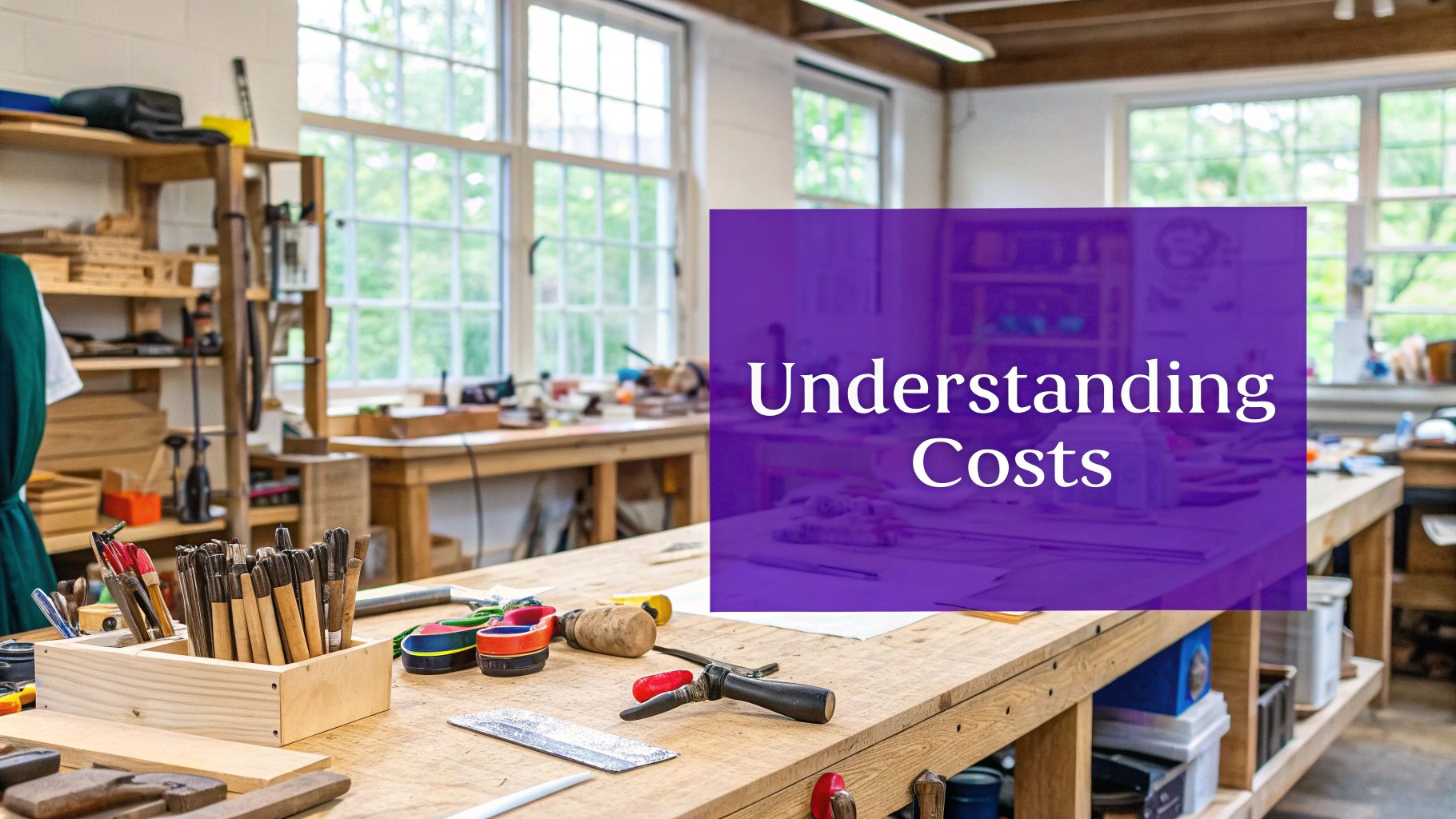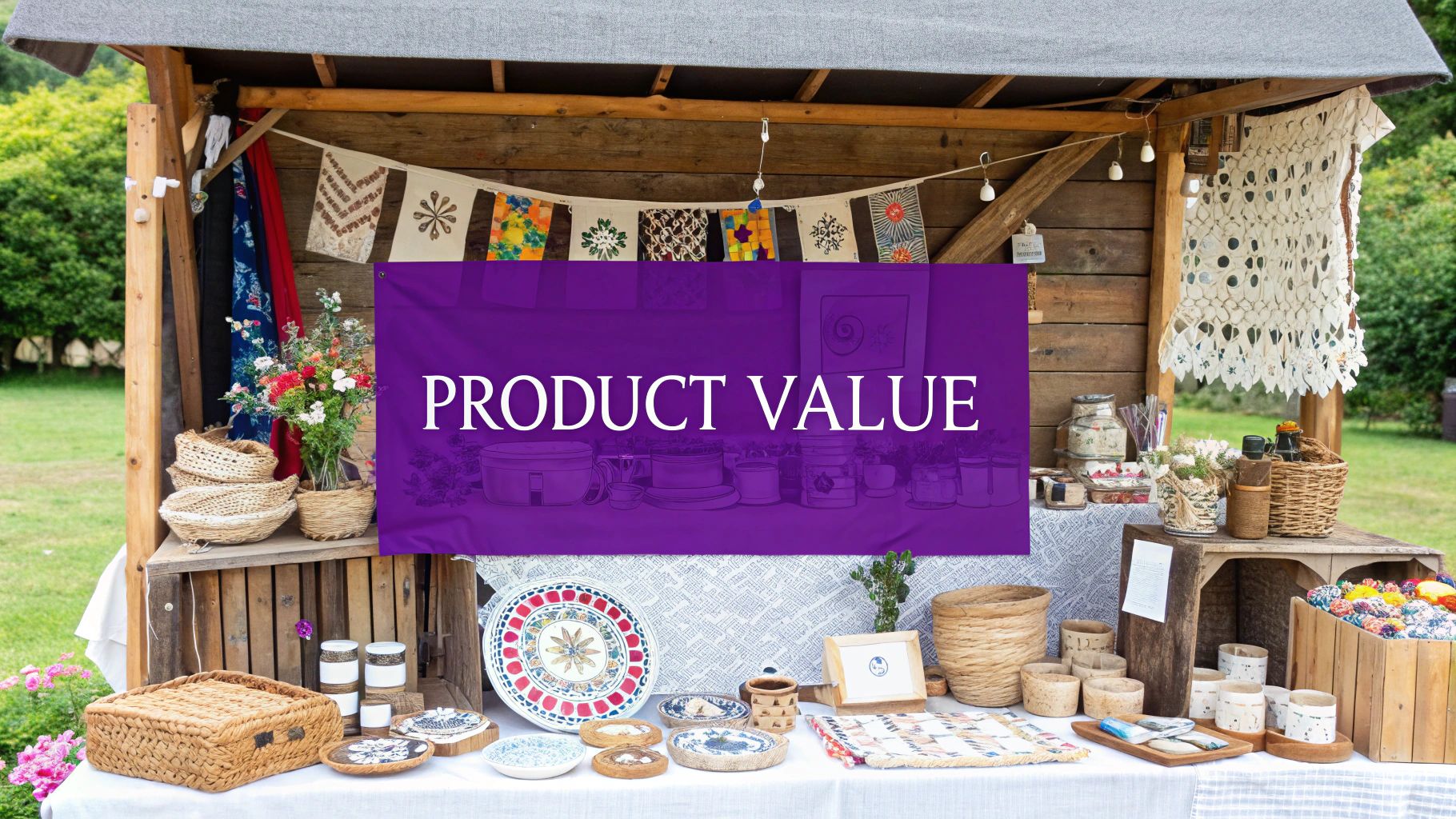How to Price Handmade Products: A Strategic Guide for Creative Business Success

Understanding Your True Product Costs
Determining the right price for your handmade items is key to running a successful creative business. It goes beyond just looking at material costs and adding a markup. You need a complete view of your total production expenses to set prices that cover your costs and help your business grow.
Direct Costs: Materials and Labor
The first step is calculating your direct costs - the materials and time that go into each piece. Track every supply purchase meticulously, including small items like thread or glue that are easy to overlook. If you make jewelry, for example, log the cost of beads, findings, packaging, and even shipping materials.
Your time is also valuable and needs to be factored in properly. Choose an hourly rate that matches your skill level, then carefully record how long you spend on design, creation, photography and other tasks for each item.
Indirect Costs: The Hidden Expenses
Beyond materials and labor are the indirect costs, also called overhead. These are ongoing business expenses that aren't tied to specific products but still impact your bottom line. This includes workspace rent, utility bills, website fees, marketing, craft fair booths, and business software.
Many makers use basic spreadsheets or accounting apps to organize and monitor these ongoing costs. Having clear records of your overhead helps ensure your pricing accounts for all your business expenses.
Getting to Your Total Cost
To price your handmade goods properly, you need to add up all the costs involved. Let's look at a leather journal example: Material costs might be €10 for leather, paper and thread. Labor at €5 per hour for 3 hours is €15. Overhead costs like packaging and listing fees add another €5. This brings the total cost to €30. Adding a 50% markup results in a €45 selling price.
Learn more about handmade product pricing
Understanding your real costs helps you price strategically and build a business that lasts. When you know your numbers, you can ensure you're being paid fairly for your work while growing your creative venture.
This is rewritten text
Mastering Market Research for Handmade Success

Getting your handmade product pricing right requires more than just calculating costs - you need to truly know your market. This means diving deep into what your customers want, learning from competitors, and spotting gaps in your niche.
Understanding Your Customer
Start by getting to know your ideal customer inside and out. Talk to them directly about what they look for in handmade items. Are they shopping for unique gifts? Do they care about eco-friendly materials? What price range feels right to them? Even casual chats with customers can give you amazing insights into their buying habits and what they value most.
Competitor Analysis: Beyond the Price Tag
While it helps to know competitor prices, don't stop there. Study how they present their brand, who they're targeting, and what makes them stand out. Maybe they excel at customer service or use premium materials. Understanding their approach helps you find your own unique angle - whether that's offering better quality, using sustainable materials, or providing a more personal touch.
Identifying Niche Opportunities
Good market research reveals hidden gems of opportunity. You might spot an unmet need for a specific type of handmade product or find a sweet spot where you can offer better value than competitors. Take handmade scarves for example - study similar products in your market, looking at quality, craftsmanship, and brand reputation to find your perfect price point. Learn more about pricing strategies. Stay alert to market changes so you can adjust prices when needed.
Positioning for Maximum Value
The key to successful pricing is showing your true worth. Market research helps you highlight what makes your products special - be it quality materials, expert craftsmanship, or your brand story. When you understand what your customers value, you can tell a compelling story that justifies your prices and attracts buyers who appreciate your work. This creates lasting business growth built on real customer connections.
Building Profit Margins That Drive Business Growth

Once you have a good handle on your costs, the next step is setting profit margins that will help your handmade business grow. Let's look at smart ways to price your products that balance making money with staying competitive in the market.
Setting Strategic Profit Margins
Your profit margin is like fuel for your business - it's what's left after subtracting all your costs from your selling price. A good margin gives you room to grow by funding things like new equipment, product development, and marketing efforts like building a professional Shopify website.
The right margin depends on your specific situation. If you make luxury one-of-a-kind items, you can often charge higher margins than if you sell everyday crafts. Take time to analyze what makes sense for your unique business.
Pricing Across Different Sales Channels
Different sales channels need different pricing strategies. When you sell directly to customers through your website or craft shows, you can keep more of the profit since there's no middleman. Wholesale orders to retailers mean sharing the profit, but can boost your total sales through higher volume. Many successful makers find ways to balance both approaches.
For handmade products, profit margins typically run between 5% and 30%. On a $100 item, that means $8-30 in profit. To price profitably, use a formula that includes materials, labor, overhead costs and fees. For example, a product costing $29 to make could sell for $72.50 with a 150% markup. Learn more about pricing handmade items.
Balancing Profitability and Market Expectations
While you need healthy profits, your prices also need to match what buyers will pay. Do thorough market research to understand competitor pricing and what customers value. Many people happily pay more for handmade items with special features, quality materials, or an authentic brand story.
Premium vs. Volume Pricing
Two main pricing approaches are premium pricing and volume-based pricing. Premium pricing works well for exclusive or custom pieces where you charge more for exceptional quality. Volume pricing aims to sell more items at lower prices, which can work if you have efficient production methods. Pick the model that fits your products and target customers. Either way, carefully track your costs and margins to keep your business healthy and growing.
Creating Dynamic Pricing Strategies That Drive Sales

Setting the right prices for handmade products goes beyond basic cost calculations. You need a flexible approach that responds to market changes, customer interest, and seasonal opportunities to grow your sales and maintain your brand value throughout the year.
Making the Most of Seasonal Products
Many handmade businesses thrive during specific seasons. Smart sellers create special themed collections for holidays like Valentine's Day and Christmas, when demand peaks. This gives you a chance to offer unique items with prices that reflect their special appeal and limited availability.
You can also use seasonal pricing to your advantage. For products with clear seasonal demand like holiday cards, consider lowering prices in off-peak times and raising them as interest grows. Rather than deeply discounting leftover seasonal stock, try removing those items and bringing them back next season at full price. Learn more about seasonal pricing strategies from The Make It Collective.
Building Excitement With Limited Offers
Limited-edition items and time-sensitive sales are great ways to get customers excited and ready to buy. When you clearly communicate that a product is only available for a short time or in small quantities, people are more likely to purchase quickly before missing out. This scarcity can also help support premium pricing.
Try releasing a special version of your most popular item with unique materials or designs. Make sure to highlight the limited nature of these offers in your product descriptions and marketing to build interest.
Managing Stock Levels Year-Round
Smart inventory planning is key for dynamic pricing success. Keep enough stock on hand during busy seasons to meet demand. During slower periods, run targeted promotions to clear excess inventory and avoid storage issues. This balanced approach helps maintain healthy cash flow.
Consider using pre-orders for seasonal items to better predict demand and produce the right quantities. This prevents having too much or too little stock while building excitement for new products.
Making Smart Price Changes
Timing matters when adjusting prices. Skip sudden big changes that might upset customers. Instead, make smaller adjustments based on material costs, market changes and competitor prices.
Be open with customers about price changes to build trust. Explain factors like increased material costs or product improvements so they understand the value. A thoughtful pricing strategy helps handmade businesses maximize profits while keeping customers happy and coming back.
Crafting Your Value Story That Justifies Premium Prices

Setting prices for handmade products goes beyond basic math. You need a compelling story that shows customers why your creations deserve higher prices. When you share what makes your work special and connect with buyers who value handcrafted items, they'll understand the true worth of what you offer.
Showcasing Your Craftsmanship
Let your unique skills and methods shine through. If you're a woodworker who uses rare local timber, explain why that wood matters. Maybe you learned a traditional weaving style passed down through generations - share that story. These details help customers see the expertise and care in your work, making your prices feel right.
Telling Your Brand Story
Share what drives you to create. Maybe nature inspires your jewelry designs, or family traditions sparked your love of pottery. When customers know the passion behind your work, they form a deeper connection with your brand. This personal touch helps them feel good about paying more to support an artist they understand and appreciate.
Building Emotional Connections
Help customers feel the joy your products bring. Rather than listing features, paint a picture of the experience. Show how your handmade pottery brings warmth to family meals, or how your knitted scarves offer cozy comfort on cold days. When people connect emotionally with your work, price becomes less of a barrier.
Using Photography, Product Descriptions, and Social Proof
Beautiful photos show off the quality of your handcrafted items. Rich descriptions help buyers imagine owning your pieces. Reviews and testimonials from happy customers build trust. Together, these elements create confidence in your brand and support your pricing.
The Power of Perceived Value
What customers will pay depends on how much they value your work. When you highlight your skills, share your story, and show the care in your craft, people understand why your pieces cost more than mass-produced items. Remember - you're offering more than just products. You're providing quality, creativity, and a connection to something meaningful. When customers truly get that, they're happy to invest in your handmade pieces.
Evolving Your Pricing Strategy for Long-Term Success
Setting prices for your handmade products is an ongoing journey that requires regular attention and adjustments. As your business grows, you'll need to refine your pricing approach to maintain profitability and stay competitive in the market.
Tracking and Analyzing Your Pricing Decisions
Smart makers keep a close eye on how their pricing affects their bottom line. Track essential numbers like sales volume, profit margins, and customer reactions. If you notice sales dropping after a price change, that's valuable feedback telling you to reassess. Having real data helps you make better pricing choices.
Responding to Market Changes
The handmade marketplace is dynamic - new sellers join, trends come and go, and supply costs shift up and down. Stay aware of what's happening in your niche. When material costs rise or new competition enters the market, be ready to adjust your prices thoughtfully.
Practical Tools for Monitoring Profitability
Simple tools can help track your pricing success. Basic spreadsheets work great for recording costs and calculating margins. QuickBooks or similar accounting software can automate financial tracking. Customer feedback forms provide direct insight into how buyers view your prices.
Implementing Price Changes Without Losing Customers
Making price changes takes a delicate touch. Be open with customers about why prices are changing, especially if costs force an increase. Remind them about your quality materials, craftsmanship time, and what makes your products special. Honesty builds trust and understanding.
Identifying Opportunities to Increase Value and Margins
As your brand gets stronger, look for ways to offer more value that supports higher prices. Consider premium materials, custom options, or special collections. Focus on what makes your work unique and valuable to customers who appreciate quality handmade items.
Frameworks for Regular Price Reviews
Set up a schedule to review your pricing strategy, like every three months. Look at your sales data, costs, and market conditions. Regular check-ins help keep your prices aligned with your goals and maintain healthy profits.
Ready to take your handmade business to the next level? Wand Websites can help you build a professional online store that showcases your products and drives sales. We offer custom Shopify websites designed to convert visitors into customers. Visit us at Wand Websites to learn more and start growing your business today!


